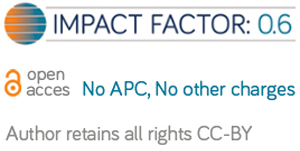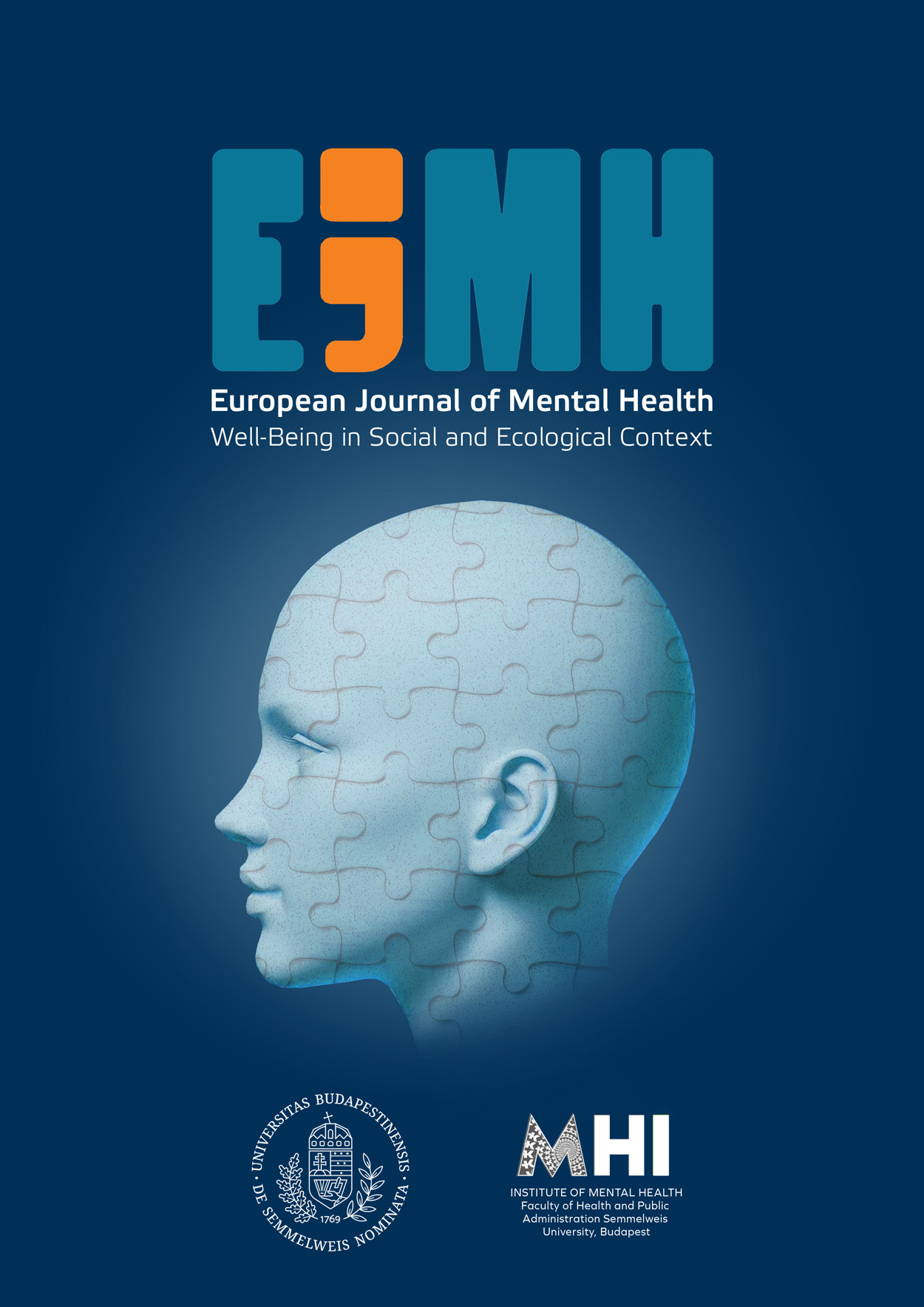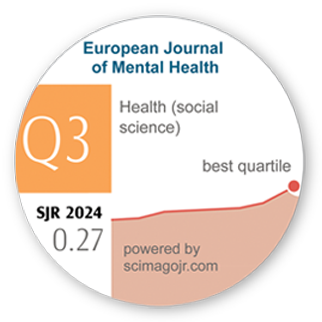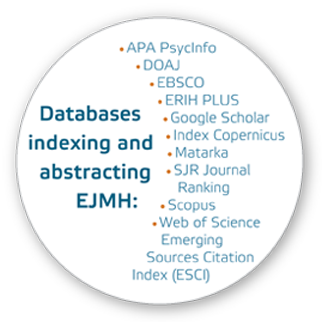Development and Validation Regarding the Lithuanian Version of the Positive and Negative Affect Schedule (PANAS-X)
DOI:
https://doi.org/10.5708/EJMH.17.2022.3.4Keywords:
positive and negative affect, emotions, PANAS-X, psychometric properties, Lithuanian adaptationAbstract
Introduction: The Positive and Negative Affect Schedule (PANAS-X), a widely used and accepted instrument developed to assess multidimensional emotional experience, is used in various social and clinical settings. It has an underlying hierarchical structure of the higher order for the positive affect (PA) and negative affect (NA), and the lower order discrete affect scales that describe specific emotions; however, very little is known about the psychometric properties that this version of the instrument has.
Aims: This study aims to investigate the psychometric properties in the Lithuanian version of PANAS-X, including the analysis for the factor structure of the higher and lower order scales, reliability, and validity characteristics.
Methods: The study includes a demographically representative Lithuanian sample (N = 322, with an average age of 37.34, SD = 12.50). For the psychometric evaluation of the PANAS-X, researchers performed item analysis, reliability, convergent-discriminant validity, and confirmatory factor analysis.
Results: The confirmatory factor analysis results support the basic structure of the PANAS-X PA, NA, and the discrete affect scales, although some scales were modified according to the item characteristics. The convergent validity is confirmed by the relations of the PA and NA as well as the discrete affect scales to the related constructs, which include personality traits, general, and psychological well-being.
Conclusions: The Lithuanian version of PANAS-X can be considered a reliable and valid instrument for structuring positive, negative, and specific emotional experiences.
References
Bagdonas, A., Liniauskaitė, A., Kairys, A., & Pakalniškienė, V. (2013). The structure of the Lithuanian Psychological Well-Being Scale in adults’ sample. Health Sciences, 23(2) 58–65.
http://dx.doi.org/10.5200/sm-hs.2013.046
Beaton, D. E., Bombardier, C., Guillemin, F., & Ferraz, M. B. (2000). Guidelines for the process of cross-cultural adaptation of self-report measures. Spine, 25(24), 3186–3191.
https://doi.org/10.1097/00007632-200012150-00014
Chambers, M. A., Guise, V., Välimäki, M., Rebelo Botelho, M. A., Scott, A., Staniulienė, V., & Zanotti, R. (2010). Nurses’ attitudes to mental illness: A comparison of a sample of nurses from five European countries. International Journal of Nursing Studies, 47(3), 350–362.
https://doi.org/10.1016/j.ijnurstu.2009.08.008
Čiužas, A., & Ratkevičienė, V. (2005). Moksleivių požiūris į lietuvybę [Schoolchildren’s attitude towards Lithuanian national identity]. In R. Grigas & L. Klimka (Eds.), Tautinės tapatybės dramaturgija: lietuvių tautinis identitetas ir integralumas kintančiame pasaulyje (pp. 234–243). Vilniaus Pedagoginio Universiteto Leidykla.
Cohen, J. M., Dryman, T., Morrison, A. S., Gilbert, K. E., Heimberg, R. G., & Gruber, J. (2017). Positive and negative affect as links between social anxiety and depression: Predicting concurrent and prospective mood symptoms in unipolar and bipolar mood disorders. Behavior Therapy, 48(6), 820–833.
https://doi.org/10.1016/j.beth.2017.07.003
Costa, P. A., Taske, F., Ramos, C., & Leal, I. (2020). Psychometric properties of the parent’s versions of the SDQ and the PANAS-X in a community sample of Portuguese parents. Clinical Child Psychology and Psychiatry, 25(2), 520–532.
https://doi.org/10.1177/1359104519891759
Costa, P. T., Jr, & McCrae, R. R. (1980). Influence of extraversion and neuroticism on subjective well-being: Happy and unhappy people. Journal of Personality and Social Psychology, 38(4), 668–678.
https://doi.org/10.1037//0022-3514.38.4.668
Cotigă, M. I. (2012). Development and validation of a Romanian version of the expanded version of Positive and Negative Affect Schedule (PANAS-X). Procedia - Social and Behavioral Sciences, 33, 248–252.
https://doi.org/10.1016/j.sbspro.2012.01.121
Crawford, J. R., & Henry, J. D. (2004). The Positive and Negative Affect Schedule (PANAS): Construct Validity, Measurement Properties and Normative Data in a Large Non-Clinical Sample. British Journal of Clinical Psychology, 43, 245–265
https://doi.org/10.1348/0144665031752934
Dahiya, R., & Rangnekar, S. (2019). Validation of the Positive and Negative Affect Schedule (PANAS) among employees in Indian manufacturing and service sector organisations. Industrial and Commercial Training, 51(3), 184–194.
https://doi.org/10.1108/ICT-08-2018-0070
Domaradzka, E., & Fajkowska, M. (2019). Structure of Affect in Types of Anxiety and Depression. Journal of Individual Differences, 40(2), 82–91.
https://doi.org/10.1027/1614-0001/a000279
Ekman, P. (1971). Universals and cultural differences in facial expressions of emotions. In J. K. Cole (Ed.), Nebraska Symposium on Motivation (Vol. 19, pp. 207–283). University of Nebraska Press.
Endriulaitienė, A., Žardeckaitė-Matulaitienė, K., Pranckevičienė, A., Markšaitytė, R., Tillman, D. R., & Hof, D. D. (2019). Self-Stigma of seeking help and job burnout in mental health care providers: The comparative study of Lithuanian and the USA samples. Journal of Workplace Behavioral Health, 34(2), 129–148.
https://doi.org/10.1080/15555240.2019.1586549
Fajkowska, M., & Marszał-Wiśniewska, M. (2009). Właściwości psychometryczne Skali Pozytywnego i Negatywnego Afektu-Wersja Rozszerzona (PANAS-X). Wstępne wyniki badań w Polskiej próbie [Psychometric properties of the Positive and Negative Affect Schedule-Expanded Form (PANAS-X). The study on a Polish sample]. Przegląd Psychologiczny, 52(4), 355–387.
Fornell, C., & Larcker, D. F. (1981). Evaluating structural equation models with unobservable variables and measurement error. Journal of Marketing Research, 18(1), 39–50.
https://doi.org/10.1177/002224378101800104
Genevičiūtė-Janonienė, G., & Endriulaitienė, A. (2008). Darbuotojų asmenybės savybių ir darbo motyvacijos sąsajos [Relationship among employee’s personality traits and work motivation]. Psichologija, 38, 100–114.
https://www.zurnalai.vu.lt/psichologija/article/view/2601/1822
Goldberg, L. R. (1993). The structure of phenotypic personality traits. American Psychologist, 48(1), 26–34.
https://doi.org/10.1037/0003-066X.48.1.26
Hair, J. F. Jr, Black, W. C., Babin, B. J., & Anderson, R. E. (2010). Multivariate data analysis: A global perspective (7th ed). Pearson Education.
Hambleton, R. K., & Bollwark, J. (1991). Adapting tests for use in different cultures: Technical issues and methods. Bulletin of the International Testing Commission, 18, 3–32.
Hu, L.-T. & Bentler, P. M. (1995). Evaluating model fit. In R. H. Hoyle (Ed.), Structural equation modeling: Concepts, issues, and applications (pp. 76–99). Sage Publications, Inc.
Izard, C. E. (1991). The psychology of emotions. Plenum Press.
Jackson, J. C., Watts, J., Henry, T. R., List, J. M., Forkel, R., Mucha, P. J., Greenhill, S. J., Gray, R. D., & Lindquist, K. A. (2019). Emotion semantics show both cultural variation and universal structure. Science, 366(6472), 1517–1522.
https://doi.org/10.1126/science.aaw8160
John, O. P., & Srivastava, S. (1999). The Big-Five trait taxonomy: History, measurement, and theoretical perspectives. In L. A. Pervin & O. P. John (Eds.), Handbook of personality: Theory and research (Vol. 2, pp. 102–138). Guilford Press.
John, O. P., Naumann, L. P., & Soto, C. J. (2008). Paradigm shift to the integrative Big Five trait taxonomy: History, measurement, and conceptual issues. In O. P. John, R. W. Robins, & L. A. Pervin (Eds.), Handbook of personality: Theory and research (pp. 114–158). Guilford Press.
Kairys A., Liniauskaitė A., Bagdonas A., & Pakalniškienė V. (2013). Verification of the structure of psychological well-being in a representative Lithuanian sample. Psichologija, 48, 7–19.
https://doi.org/10.15388/Psichol.2013.1.2629
Krohne, H. W., Egloff, B., Kohlmann, C. W., & Tausch, A. (1996). Untersuchungen mit einer deutschen Version der "Positive and Negative Affect Schedule" (PANAS) [Investigations with a German version of the Positive and Negative Affect Schedule (PANAS)]. Diagnostica, 42(2), 139–156.
Lim, Y-J., Yu, B-H., Kim, D-K., & Kim, J-H. (2010). The Positive and Negative Affect Schedule: Psychometric properties of the Korean version. Psychiatry Investigation, 7(3), 163–169.
https://doi.org/10.4306/pi.2010.7.3.163
Livaniene, V., & De Raad, B. (2016). The factor structure of Lithuanian personality-descriptive adjectives of the highest frequency of use. International Journal of Psychology, 52(6), 453–462
https://doi.org/10.1002/ijop.12247
Maslenikova, V., & Bulotaitė, L. (2013). Emociniai išgyvenimai, emocijų reguliacija ir depresiškumas senatvėje. [Emotional experience, emotion regulation, and depression in the elderly age]. Gerontologija, 14(3), 159–165.
Merz, E. L., Malcarne, V. L., Roesch, S. C., Ko, C. M., Emerson, M., Roma, V. G., & Sadler, G. R. (2013). Psychometric properties of Positive and Negative Affect Schedule (PANAS) original and short forms in an African American community sample. Journal of Affective Disorders, 151(3), 942–949.
https://doi.org/10.1016/j.jad.2013.08.011
Mihić, L., Novović, Z., Čolović, P., & Smederevac, S. (2014). Serbian adaptation of the Positive and Negative Affect Schedule (PANAS): Its facets and second-order structure. Psihologija, 47(4), 393–414.
https://doi.org/10.2298/PSI1404393M
Muthén, L.K. & Muthén, B.O. (2017). Mplus. User’s guide (7th ed.).
Ortuño-Sierra, J., Bañuelos, M., Pérez de Albéniz, A., Molina, B. L., & Fonseca-Pedrero, E. (2019). The study of Positive and Negative Affect in children and adolescents: New advances in a Spanish version of the PANAS. Plos One, 14(8), Article e0221696.
https://doi.org/10.1371/journal.pone.0221696
Papaurėlytė-Klovienė, S. (2009). Lithuanian national character in Lithuanian world-view: Can we call ourselves the most hard-working detractors? Acta Humanitarica Universitatis Saulensis, 8(8), 244–252.
Penfield, R. D. (2013). Item analysis. In K. F. Geisinger, B. A. Bracken, J. F. Carlson, J.-I. C. Hansen, N. R. Kuncel, S. P. Reise, & M. C. Rodriguez (Eds.), APA handbook of testing and assessment in psychology: Testing theory and testing and assessment in industrial and organizational psychology. Vol. 1. Test theory and testing and assessment in industrial and organizational psychology (pp. 121–138). American Psychological Association.
https://doi.org/10.1037/14047-007
Psychiatric Research Unit, WHO Collaborating Centre in Mental Health. (1999). PSO (5) geros savijautos rodiklis [WHO-5 Well-Being Index].
https://www.psykiatri-regionh.dk/who-5/Documents/WHO5_Lithuanian.pdf
Raykov, T., R., & Grayson, D. (2003). A test for change of composite reliability in scale development. Multivariate Behavioral Research, 38(2), 143–159.
https://doi.org/10.1207/S15327906MBR3802_1
Rhemtulla, M., Brosseau-Liard, P. E., & Savalei, V. (2012). When can categorical variables be treated as continuous? A comparison of robust continuous and categorical SEM estimation methods under suboptimal conditions. Psychological Methods, 17(3), 354–373.
https://doi.org/10.1037/a0029315
Ryff, C. D., & Keyes, C. L. M. (1995). The structure of psychological well-being revisited. Journal of Personality and Social Psychology, 69(4), 719–727.
https://doi.org/10.1037/0022-3514.69.4.719
Sato, A., & Yasuda, A. (2001). Development of the Japanese version of Positive and Negative Affect Schedule (PANAS) scales. The Japanese Journal of Personality, 9(2), 138–139.
Serafini, K., Malin-Mayor, B., Nich, C., Hunkele, K., & Carroll, K. M. (2016). Psychometric properties of the Positive and Negative Affect Schedule (PANAS) in a heterogeneous sample of substance users. The American Journal of Drug and Alcohol Abuse, 42(2), 203–212.
https://doi.org/10.3109/00952990.2015.1133632
Šilinskas, G., & Žukauskienė, R. (2004). Subjektyvios gerovės išgyvenimas ir su juo susiję veiksniai vyrų imtyje. Imtyje. [Correlates of subjective well-being in male sample]. Psichologija, 30, 47–58.
https://doi.org/10.15388/Psichol.2004..4347
Statistics Lithuania (2012). Lithuanian 2011 Population Census in Brief.
https://osp.stat.gov.lt/gyventoju-ir-bustu-surasymai1
Terraciano, A., McCrae, R. R., & Costa, P. T. Jr. (2003). Factorial and construct validity of the Italian Positive and Negative Affect Schedule (PANAS). European Journal of Psychological Assessment, 19(2), 131–141.
https://doi.org/doi:10.1027//1015-5759.19.2.131
Watson, D., & Clark, L.A. (1992). On traits and temperament - General and specific factors of emotional experience and their relation to the 5-factor model. Journal of Personality, 60(2), 441–476.
https://doi.org/10.1111/j.1467-6494.1992.tb00980.x
Watson, D., & Clark, L. A. (1999). The PANAS-X: Manual for the positive and negative affect schedule-expanded form. Psychology Publications.
Watson, D., & Stanton, K. (2017). Emotion blends and mixed emotions in the hierarchical structure of affect. Emotion Review, 9(2), 99–104.
https://doi.org/10.1177/1754073916639659
Watson, D., & Stanton, K. (2019). Positive emotional disturbance in psychopathology: A hierarchical structural approach. In J. Gruber (Ed.), The Oxford handbook of positive emotion and psychopathology (pp. 64–80). Oxford University Press.
Watson, D., & Tellegen, A. (1985). Toward a consensual structure of mood. Psychological Bulletin, 98(2), 219–235.
https://doi.org/10.1037/0033-2909.98.2.219
Watson, D., Clark, L. A., & Tellegen, A. (1988). Development and validation of brief measures of positive and negative affect: The PANAS scales. Journal of Personality and Social Psychology, 54(6), 1063–1070.
https://doi.org/10.1037/0022-3514.54.6.1063
World Health Organization. (1998). Wellbeing measures in primary health care/ the Depcare project.
http://www.euro.who.int/__data/assets/pdf_file/0016/130750/E60246.pdf
World Health Organization. (2019). Suicide in the world: Global health estimates.
https://apps.who.int/iris/handle/10665/326948
Xia, Y., & Yang, Y. (2019). RMSEA, CFI, and TLI in structural equation modelling with ordered categorical data: The story they tell depends on the estimation methods. Behavior Research Methods, 51, 409–428.
https://doi.org/10.3758/s13428-018-1055-2
Zevon, M. A., & Tellegen, A. (1982). The structure of mood change: An idiographic/nomothethic analysis. Journal of Personality and Social Psychology, 43(1), 111–122.
https://doi.org/10.1037/0022-3514.43.1.111






